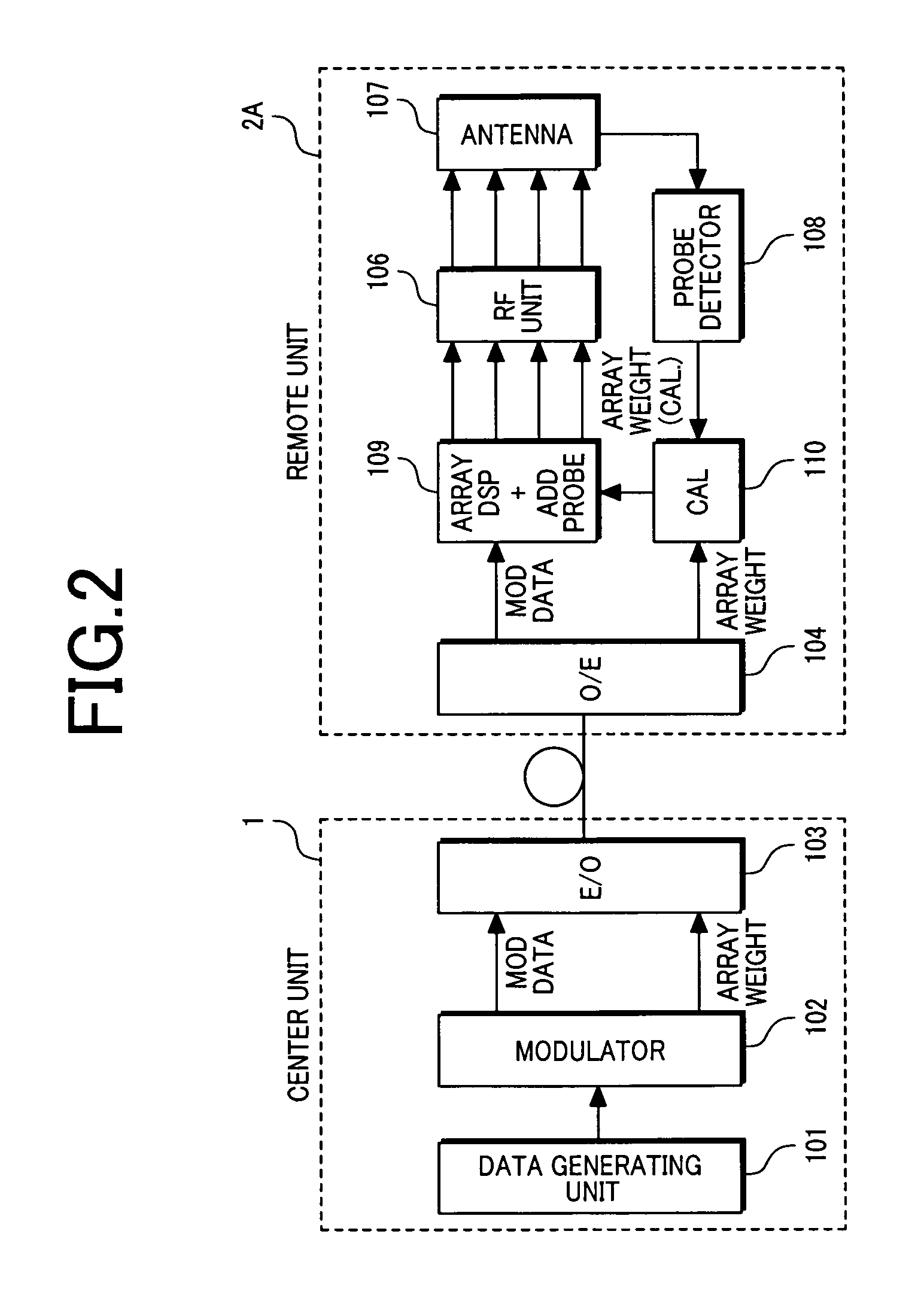System and method for correcting signal deviations in a radio over fiber network
a fiber network and radio technology, applied in the field of wireless base stations, can solve the problems such as the inability to form desired patterns, and achieve the effect of reducing bandwidth and simplifying the operation of the wireless base station, and reducing the need for bandwidth
- Summary
- Abstract
- Description
- Claims
- Application Information
AI Technical Summary
Benefits of technology
Problems solved by technology
Method used
Image
Examples
first embodiment
FIG. 1 is a configuration diagram showing a first embodiment of a wireless base station according to the present invention.
The base station comprises a center unit 1 and a remote unit 2 that are interconnected by an optical fiber. The base station shown here is used for networks of mobile wireless communication, such as represented by cellular communication. In the case where multiple base stations are requiring service area, multiple remote units 2 can be distributedly located, and multiple center units 1 connected to the remote units 2 can be concentrically located in a specific site. In addition, although not shown in the drawings, the configuration may be such that multiple remote units 2 are connected to a single center unit 1, and the transmission signal is distributed from the same center unit 1 to the respective remote units 2.
The remote unit 2 is a small apparatus that is placed on a building roof, a telegraph pole, or the like, and processes the transmission signal supplie...
second embodiment
FIG. 2 is a configuration diagram showing a second embodiment of a wireless base station according to the present invention. The second embodiment is different from the first embodiment in the configuration of the remote unit.
In the present embodiment, the array processor unit 105 shown in FIG. 1 is divided into an array processor unit 109 for processing modulated transmission signal (MOD data) and a weight compensation unit 110 for compensating for array weights based on the output information from the probe detector 108.
The weight compensation unit 110 stores array weights output from the remote-unit optical interface 104 into a memory. The weight compensation unit 110 generates complex vector information for compensating for the phase or amplitude of an output signal from a specific antenna element based on output information from the remote-unit optical interface 104, and performs the multiplication between the array weights stored in the memory and the complex vector informatio...
third embodiment
As a third embodiment according to the present invention, FIG. 3 shows a configuration diagram of a wireless base station employing a multi-input multi-output (MIMO) technique.
In the MIMO type wireless base station, the streams of transmission signals are different from one another for the respective antenna elements. Therefore, plural streams of transmission signals corresponding to the respective antenna elements have to be generated when the base band modulation has been performed in a center unit 1B. For this reason, in the case of MIMO type wireless base station, different from the case of the first and second embodiment, the center unit 1B cannot transmit a base band signal common to the plurality of antenna elements to the remote unit 2 through the optical fiber.
In the MIMO type wireless base station has a problem to be solved particularly when level deviations occurred across transmission signals, such that compensation has to be performed to attain equalization of the level...
PUM
 Login to View More
Login to View More Abstract
Description
Claims
Application Information
 Login to View More
Login to View More - R&D
- Intellectual Property
- Life Sciences
- Materials
- Tech Scout
- Unparalleled Data Quality
- Higher Quality Content
- 60% Fewer Hallucinations
Browse by: Latest US Patents, China's latest patents, Technical Efficacy Thesaurus, Application Domain, Technology Topic, Popular Technical Reports.
© 2025 PatSnap. All rights reserved.Legal|Privacy policy|Modern Slavery Act Transparency Statement|Sitemap|About US| Contact US: help@patsnap.com



